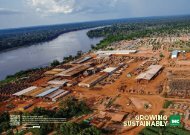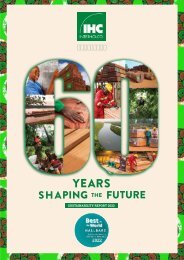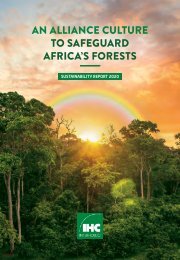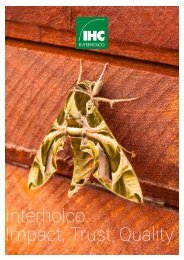Enabling Landscapes: INTERHOLCO's Sustainability Report 2017
Interholco presents its first stand-alone Sustainability Report simultaneously in Baar, Switzerland and in Vancouver, Canada, where the Forest Stewardship Council (FSC) General Assembly 2017 has just been kicked off. Interholco is an active participant at this General Assembly. To find out more: https://interholco.com/images/pdfs/Enabling-Landscapes-INTERHOLCO-Sustainability-Report-2017-.pdf
Interholco presents its first stand-alone Sustainability Report simultaneously in Baar, Switzerland and in Vancouver, Canada, where the Forest Stewardship Council (FSC) General Assembly 2017 has just been kicked off. Interholco is an active participant at this General Assembly.
To find out more: https://interholco.com/images/pdfs/Enabling-Landscapes-INTERHOLCO-Sustainability-Report-2017-.pdf
You also want an ePaper? Increase the reach of your titles
YUMPU automatically turns print PDFs into web optimized ePapers that Google loves.
Notes<br />
1 The incidence rates represent the number of injuries and illnesses per 100 full-time workers and were calculated as: (N/EH) x 200'000, where N = number of injuries and illnesses EH = total hours<br />
worked by all employees during the calendar year (2'000 x nb. of full time workers that year). 200'000 = base for 100 equivalent full-time workers (working 40 hours per week, 50 weeks per year or<br />
2'000 hours per worker).<br />
2 ‘Affected staff’ i.e. staff who might be exposed to issues such as corruption, illegal logging and forced labour. Key positions include all procurement (including production purchasing) staff, all sales<br />
staff, finance and human resources personnel.<br />
3 For all operations there are impact assessments:<br />
- 85 villages in the forest concession and max. 10 villages affected by the yearly harvest.<br />
- for the whole FMU, a socio-economic study (2004) and a social impact assessment (2008) have been carried out.<br />
- before the annual harvest, a 'participatory cartography' is done and all sites with particular importance for communities are identified;<br />
- all villages are informed about the social & environmental impacts and mitigating measures implemented;<br />
- a consultation platform with 25 village representatives and all stakeholders (including representatives of the local administration and NGOs) is held once or twice a year.<br />
4 Most impacts are temporary and can be positive and negative at the same time:<br />
- Negative: disturbance of the village trails in the forest (for hunting / gathering).<br />
- Positive: after harvest, the trails are materialised again if requested by the villages / communities.<br />
5 2016-2015 data.<br />
6 A human rights training was carried out in 2015, for both eco-guards and security staff.<br />
7 The security personnel operating at IFO do not carry any weapons.<br />
8 Affected positions included the following: local administration (police, gendarmerie), IFO Environment and Forest Director, security guards and eco-guards together with ADHUC and CDHD.<br />
9 This figure only takes into account IFO employees. 20 local authorities and 25 eco-guards and IFO employees attended this training in 2015 (total participants: 45).<br />
10 We have protected the areas with the official classification in the forest management plan of the Forest management Unit Ngombé, approved by Ministerial Decree. In addition, we have established<br />
to protect a buffer zone along the Odzala Kokoua national park, to prevent any possible negative influence on the national park. An active HCV management has taken place over the years, to protect<br />
HCV values (active wildlife management, protection of buffer zone, monitoring of conservation areas, etc.).<br />
11 The impacts of harvesting are only on 1/30 of the production area (800'000 ha), based on the area to be harvested as per our Forest Management Plan.<br />
12 Only small oil spills. All waste and oil is collected at the base camp and send back to the Ngombé industrial site, where it is threated, re-used or sent to approved waste collection plants (in Pointe<br />
Noire).<br />
13 Not applicable, no specific invasive species. Marantaceae and Zingiberaceae herbs are naturally invading areas, but harvest can have a positive impact on forest regeneration.<br />
14 No significant reduction in species. All trees species are managed to be maintained, or only decline in case of natural replacement in certain areas (forest succession).<br />
15 There is only small impact of forest harvest (roads, skid trails, logging gaps), but no large scale conversion to non-forest land-use.<br />
16 Calculation of % of CO 2<br />
eq. stored in wood based on: 2006 IPCC Guidelines for National Greenhouse Gas Inventories, Chapter 12. Harvested Wood Products, Table 12.4, C content per m 3 / of wood<br />
0.295 t/m3 x 44/12 = CO 2<br />
eq. content / m 3 of wood = 1.08.<br />
17 Conversion: 2.27 tCO 2<br />
eq. / m 3 gasoline. Source: World Resources Institute (2015). GHG Protocol tool for mobile combustion. Version 2.6, with emissions factors from UK DEFRA and US EPA and<br />
the IPCC, 2006 Guidelines for National GHG Inventories. Scope 1, 'other countries'.<br />
18 Conversion: 2.68 tCO 2<br />
eq. / m 3 diesel: World Resources Institute (2015). GHG Protocol tool for mobile combustion. Version 2.6, with emissions factors from UK DEFRA and US EPA and the IPCC,<br />
2006 Guidelines for National GHG Inventories. Scope 1, 'other countries'.<br />
19 Conversion: 2.69 tCO 2<br />
eq. / m 3 diesel. Source: World Resources Institute (2015).GHG protocol tool for stationary combustion. Version 4.1. , Emissions factors cf. the 2006 IPCC Guidelines for National<br />
Greenhouse Gas Inventories. Scope 1, 'other countries'.<br />
20 Calculated as: (tCO 2<br />
emission of non renewable fuel in forest production, for logs transformed in the sawmill + tCO 2<br />
emission of non renewable fuel in sawmill production) / annual lumber production.<br />
21 tCO 2<br />
emission of non renewable fuel in forest production per m 3 .<br />
22 Calculated according to volume (weight) transported per method (road, train) and destination (Douala, Pointe Noire) with the tool of “World Resources Institute (2015). GHG Protocol tool for mobile<br />
combustion. Version 2.6, with emissions factors from UK DEFRA and US EPA and the IPCC, 2006 Guidelines for National GHG Inventories (Scope 2, 'other countries')”.<br />
23 Calculated according to volume (weight) transported by shipping/large container vessel from Douala, Pointe Noire to client's destination port with the tool of “World Resources Institute (2015). GHG<br />
Protocol tool for mobile combustion. Version 2.6, with emissions factors from UK DEFRA and US EPA and the IPCC, 2006 Guidelines for National GHG Inventories (Scope 2, 'other countries')”.<br />
24 Conversion from tonnes to m 3 by density of tropical wood cf. IPCC, 2006, Ch. 12, Table 12.4 (in tonnes / m 3 ) = 0.59. Total tCO 2<br />
eq. / volume transported.<br />
25 Conversion from tonnes to m 3 by density of tropical wood cf. IPCC, 2006, Ch. 12, Table 12.4 (in tonnes / m 3 ) = 0.59. Total tCO 2<br />
eq. / volume transported.<br />
26 Includes transport from Ngombé to Douala and Pointe Noire.<br />
27 Due to disassociation from FSC, no FSC wood could be produced by IFO until Nov. 2014. Therefore, a large part of wood was '3rd party legality verified'. Production, however, continued according to<br />
the same standards.<br />
28 Due to disassociation from FSC, no FSC wood could be produced by IFO until Nov. 2014. Therefore, a large part of wood was '3rd party legality verified'. Production, however, continued according to<br />
the same standards.<br />
All photos © Interholco unless otherwise stated, except on p.14-15 © Teseum / Flickr. The info graphics on p. 65 have been reproduced by kind permission of STTC.
















